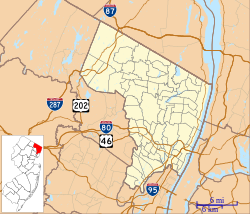New Milford Plant of the Hackensack Water Company | |
 | |
| Location | New Milford Avenue, Oradell, New Jersey |
|---|---|
| Coordinates | 40°56′49″N74°1′30″W / 40.94694°N 74.02500°W |
| Area | 13.3 acres (5.4 ha) |
| Built | 1882 |
| Architect | Brush, Charles Benjamin; Tierney, Myles |
| Architectural style | Late Victorian, Romanesque |
| NRHP reference No. | 01000891 [1] |
| NJRHP No. | 1922 [2] |
| Significant dates | |
| Added to NRHP | August 22, 2001 |
| Designated NJRHP | June 21, 2001 |
The New Milford Plant of the Hackensack Water Company was a water treatment and pumping plant located on Van Buskirk Island, an artificially created island in the Hackensack River, in Oradell, Bergen County, New Jersey, United States. [3] The site was purchased in 1881 by the Hackensack Water Company, which developed it for water supply use. The facility was built between 1881 and 1911, and it includes a brick pumping station from 1882, a tall filtration tower, and huge underground infrastructure. [4] The Hackensack Water Company was merged into United Water in the 1980s; the successor today is Suez North America.


